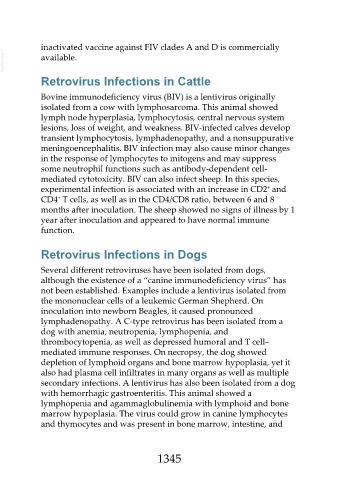Page 1345 - Veterinary Immunology, 10th Edition
P. 1345
inactivated vaccine against FIV clades A and D is commercially
VetBooks.ir available.
Retrovirus Infections in Cattle
Bovine immunodeficiency virus (BIV) is a lentivirus originally
isolated from a cow with lymphosarcoma. This animal showed
lymph node hyperplasia, lymphocytosis, central nervous system
lesions, loss of weight, and weakness. BIV-infected calves develop
transient lymphocytosis, lymphadenopathy, and a nonsuppurative
meningoencephalitis. BIV infection may also cause minor changes
in the response of lymphocytes to mitogens and may suppress
some neutrophil functions such as antibody-dependent cell-
mediated cytotoxicity. BIV can also infect sheep. In this species,
+
experimental infection is associated with an increase in CD2 and
+
CD4 T cells, as well as in the CD4/CD8 ratio, between 6 and 8
months after inoculation. The sheep showed no signs of illness by 1
year after inoculation and appeared to have normal immune
function.
Retrovirus Infections in Dogs
Several different retroviruses have been isolated from dogs,
although the existence of a “canine immunodeficiency virus” has
not been established. Examples include a lentivirus isolated from
the mononuclear cells of a leukemic German Shepherd. On
inoculation into newborn Beagles, it caused pronounced
lymphadenopathy. A C-type retrovirus has been isolated from a
dog with anemia, neutropenia, lymphopenia, and
thrombocytopenia, as well as depressed humoral and T cell–
mediated immune responses. On necropsy, the dog showed
depletion of lymphoid organs and bone marrow hypoplasia, yet it
also had plasma cell infiltrates in many organs as well as multiple
secondary infections. A lentivirus has also been isolated from a dog
with hemorrhagic gastroenteritis. This animal showed a
lymphopenia and agammaglobulinemia with lymphoid and bone
marrow hypoplasia. The virus could grow in canine lymphocytes
and thymocytes and was present in bone marrow, intestine, and
1345

